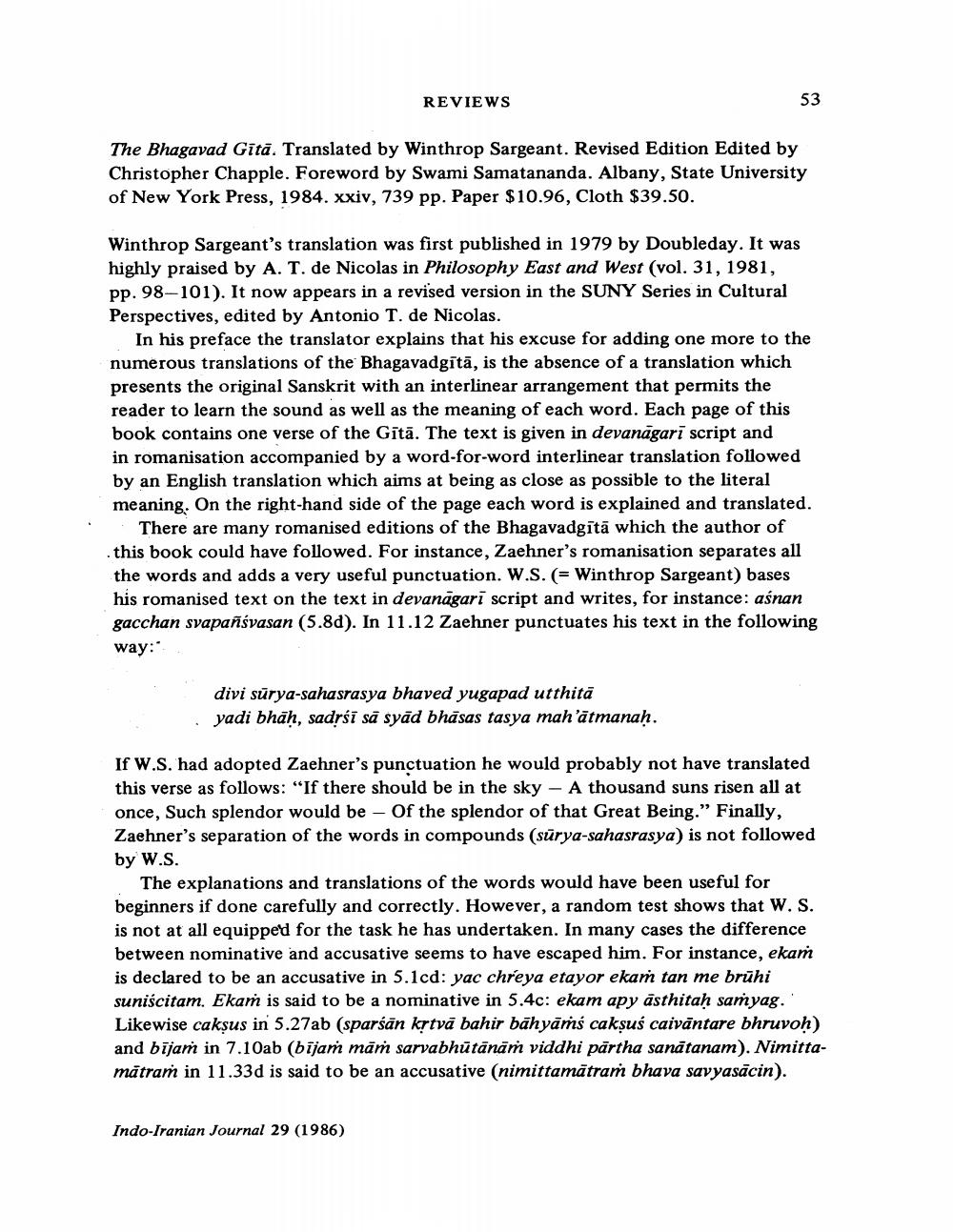Book Title: Reviews Of Diffeent Books Author(s): J W De Jong Publisher: J W De Jong View full book textPage 5
________________ REVIEWS 53 The Bhagavad Gitā. Translated by Winthrop Sargeant. Revised Edition Edited by Christopher Chapple. Foreword by Swami Samatananda. Albany, State University of New York Press, 1984. xxiv, 739 pp. Paper $10.96, Cloth $39.50. Winthrop Sargeant's translation was first published in 1979 by Doubleday. It was highly praised by A. T. de Nicolas in Philosophy East and West (vol. 31, 1981, pp. 98-101). It now appears in a revised version in the SUNY Series in Cultural Perspectives, edited by Antonio T. de Nicolas. In his preface the translator explains that his excuse for adding one more to the numerous translations of the Bhagavadgitā, is the absence of a translation which presents the original Sanskrit with an interlinear arrangement that permits the reader to learn the sound as well as the meaning of each word. Each page of this book contains one verse of the Gītā. The text is given in devanagari script and in romanisation accompanied by a word-for-word interlinear translation followed by an English translation which aims at being as close as possible to the literal meaning. On the right-hand side of the page each word is explained and translated. There are many romanised editions of the Bhagavadgitā which the author of this book could have followed. For instance, Zaehner's romanisation separates all the words and adds a very useful punctuation. W.S. (= Winthrop Sargeant) bases his romanised text on the text in devanāgarī script and writes, for instance: aśnan gacchan svapañsvasan (5.8d). In 11.12 Zaehner punctuates his text in the following way: divi sürya-sahasrasya bhaved yugapad utthitā yadi bhah, sadrśī să syād bhāsas tasya mah'ātmanah. If W.S. had adopted Zaehner's punctuation he would probably not have translated this verse as follows: "If there should be in the sky - A thousand suns risen all at once, Such splendor would be – Of the splendor of that Great Being.” Finally, Zaehner's separation of the words in compounds (surya-sahasrasya) is not followed by W.S. The explanations and translations of the words would have been useful for beginners if done carefully and correctly. However, a random test shows that W. S. is not at all equipped for the task he has undertaken. In many cases the difference between nominative and accusative seems to have escaped him. For instance, ekam is declared to be an accusative in 5.1cd: yac chreya etayor ekaṁ tan me brūhi suniscitam. Ekaṁ is said to be a nominative in 5.4c: ekam apy asthitaḥ samyag. Likewise caksus in 5.27ab (sparsân krtvā bahir bāhyāmś cakşuś caivāntare bhruvoh) and bījam in 7.10ab (bijam māṁ sarvabhūtānāṁ viddhi partha sanātanam). Nimittamatram in 11.33d is said to be an accusative (nimittamātram bhava savyasācin). Indo-Iranian Journal 29 (1986)Page Navigation
1 ... 3 4 5 6 7 8 9 10 11 12 13 14 15 16 17 18 19 20 21 22 23 24 25 26 27
